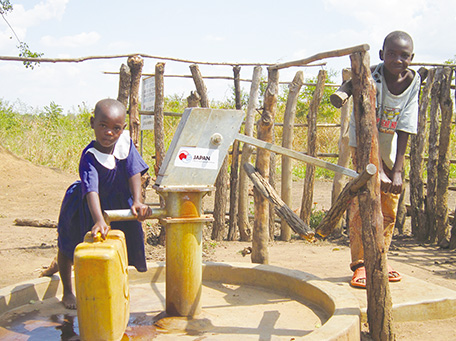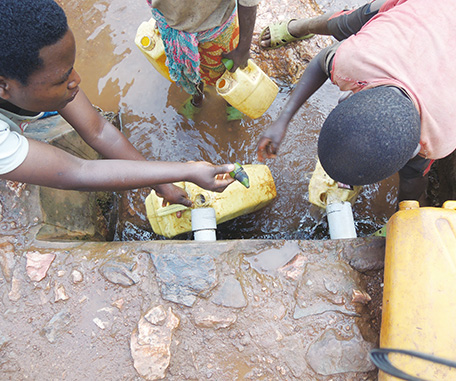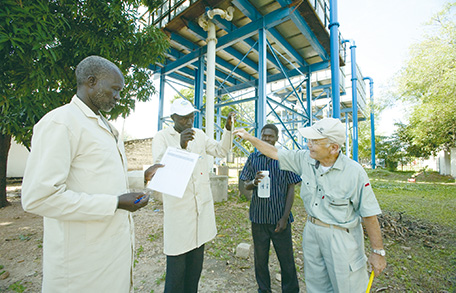Japan's Official Development Assistance White Paper 2013
(3) Water and Sanitation
Water and sanitation is a serious issue related to human life. In 2011, approximately 768 million people worldwide had no access to safe drinking water such as water supply or wells and approximately 2.5 billion people—about a half of the population of developing countries—had no access to basic sanitation such as sewage systems. (Note 4) More than 11% of children under five years old lose their lives due to diarrhea caused by a lack of safe water and basic sanitation facilities. (Note 5)
<Japan’s Efforts>
At the Fourth World Water Forum in 2006, Japan announced the Water and Sanitation Broad Partnership Initiative (WASABI). Japan’s disbursements of aid for water and sanitation are the largest in the world. Japan provides comprehensive support for both the knowledge and expertise as well as the equipment and facilities based on Japan’s experiences, knowledge, and technology in the following: (i) promotion of integrated water resources management; (ii) provision of safe drinking water and basic sanitation (improvement of sanitation facilities); (iii) support regarding water use for food production and other purposes (e.g. water for agricultural use); (iv) water pollution prevention (establishing effluent regulations) and ecosystem conservation (conservation of vegetation and sustainable forest management, etc.); and (v) mitigation of damage from water-related disasters (establishment of an early warning system and strengthening the disaster response capacities of individuals and local communities).
In December 2010, Japan led the adoption of the U.N. General Assembly Resolution on the follow-up of the International Year of Sanitation (2008), and is supporting global efforts to achieve “Sustainable Sanitation: Five-year Drive to 2015,” towards 2015, which is the target year to achieve the MDGs.
Since TICAD IV in 2008, Japan has been promoting the development of water and sanitation facilities, and by 2012 it has: (i) implemented grant aid and loan aid projects to provide safe drinking water to 10.79 million people; and (ii) provided support for the capacity building of more than 13,000 managers and users in the field of water resources (including the relevant personnel in the water management cooperative association of villages).
In addition, at TICAD V in June 2013, Japan announced that it would continue providing support for ensuring access to safe drinking water and basic sanitation facilities for approximately 10 million people for a period of five years, as well as provide support for fostering 1,750 waterworks engineers.

Smiling children pumping water from a well in Kitgum District in Northern Uganda. (Photo: Aigoual Leonard Francis / Embassy of Japan in Uganda)

Children collecting water from a spring into plastic jerry cans in Rwanda. Collecting water is a job for children. (Photo: Akiko Nakatomi / Embassy of Japan in Uganda)
Note 4: Source: “Progress on Sanitation and Drinking-Water: 2013 Update” (WHO/UNICEF)
Note 5: Source: “Committing to Child Survival: A Promise Renewed” (UNICEF, 2012)
●Burkina Faso
Project for Enhancement of Water Supply Infrastructure Management and Hygiene and Sanitation in the Regions of Central Plateau
Technical Cooperation Project (June 2009 – June 2013)
Burkina Faso is located in the Sahel region in West Africa. Securing safe water has been a constant priority for the people in this country. In the Central Plateau and Southern Central regions, Japan has installed 300 wells through grant aid, as well as implemented the Technical Cooperation Project, “Project for Enhancement of Water Supply Infrastructure Management and Hygiene and Sanitation in the Regions of Central Plateau (PROGEA),” for the proper maintenance and management of wells.
This Technical Cooperation Project was designed to establish a system of maintaining and managing wells through residents’ own efforts. Organizing a “well management committee” per well that consists of residents, among other activities, allow the operating rate of a well to be improved.
The project provided aid towards clarifying the roles and responsibilities of key stakeholders, such as local public bodies, water utilization cooperatives comprised of several well management committees, and pump repairers, and establishing good hygiene habits, such as hand washing.
As part of the project’s activities, water utilization cooperatives, which were established on a pilot basis in 80 villages, have been established in nearly all of the villages (563 villages) in the region with the understanding of residents, and could possibly expand nationwide.

Residents collecting water from a well maintained and managed by a water utilization cooperative (Photo: Takeshi Ono / Earth and Human Corporation)
●South Sudan
The Project for Management Capacity Enhancement of South Sudan Urban Water Corporation
Technical Cooperation Project (November 2010 – November 2013)
South Sudan gained independence in July 2011, but has grappled with domestic infrastructure facilities that were minimally maintained and managed due to more than 20 years of civil war. Waterworks facilities were no exception. Except for some refurbishment, water supply facilities in South Sudan’s capital have been inadequately managed since their construction in the 1930s. Consequently, the water supply after independence had covered no more than roughly 8% of the population (approx. 30,000 people). Many of the city’s people relied on untreated water collected from the White Nile River, or shallow well water with high saline concentrations. Moreover, distributing water in a planned and efficient manner had been fraught with challenges due to various factors, including the lack of knowledge and skills in waterworks management of the personnel of South Sudan Urban Water Corporation and the Corporation’s insufficient budget.
Japan therefore started a Technical Cooperation Project to South Sudan from 2010. This Technical Cooperation Project, for example, has strengthened the Corporation’s capacities to maintain and manage waterworks facilities, manage water quality, and manage the Corporation’s finances. This three-year cooperation has equipped the personnel with the ability to create records of water quality inspections on their own, which in turn has led to improvements in water quality. In addition, the personnel can now create reports on water fee collection, which has contributed to fee revenue increases. In parallel with the Grant Aid projects to expand the facilities at the Juba water treatment plant and to develop water delivery pipelines, Japan aims to increase the Juba population with water supply access by more than ten times the current number to around 350,000 people.

An expert giving onsite guidance regarding water quality sampling to staff of the Division of Water Quality Testing (Photo: JICA South Sudan Office)
